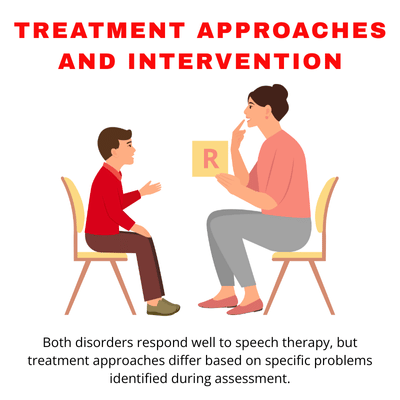
When your child has unclear speech, you might hear terms like “articulation disorder” or “phonological disorder.” Both are types of speech sound disorders, but they affect children in different ways. A proper language assessment looks at phonology, sound substitutions, and intelligibility to see how well others can understand your child. Understanding these differences helps you get the right speech therapy and support for your child’s speech development.
For children with articulation issues, articulation therapy may focus on correcting how sounds are made. A thorough language assessment helps guide this process and shows whether the problem is about single sounds or broader patterns. When the issue involves patterns in speech, speech therapy uses strategies to address phonology directly.
Getting an early language assessment ensures the right intervention is provided at the right time, giving your child the best chance for clear communication and stronger overall development.
What Is an Articulation Disorder?

An articulation disorder happens when a child can’t make certain consonant sounds or vowels correctly. The problem lies with motor movement and tongue placement. Your child knows what they want to say, but their mouth can’t form the sounds properly using their speech mechanisms.
Children with articulation disorders make the same sound errors every time. For example, they might always say “wabbit” instead of “rabbit” or “thun” instead of “sun.” These articulation errors affect specific sounds that should be mastered by a certain age.
The main types of articulation errors include substitutions, omissions, distortions, and additions. Substitutions happen when one sound replaces another. Omissions occur when sounds get left out. Distortions change how a sound comes out, affecting sound production. Additions insert extra sounds where they don’t belong.
These errors often stem from physical challenges. Sometimes structural problems cause an articulation disorder. Hearing loss can also play a role. Other times, the cause stays unknown, but the child simply needs more time to develop proper articulation skills.
What Is a Phonological Disorder?
A phonological disorder affects how children understand and use sound patterns in their phonology. Unlike an articulation disorder, the child can physically make the sounds. The problem is knowing when and where to use phonemes correctly within syllable structure.
Children with phonological disorders follow error patterns that affect whole groups of sounds. They might drop all final sounds from words or replace back sounds with front sounds. These phonological processes are normal in young children but should fade by certain ages.
Common phonological processes include final consonant deletion, which removes ending sounds. Fronting swaps back sounds for front ones. Gliding replaces “r” and “l” with “w” or “y.” Cluster reduction simplifies sound blends. Stopping changes flowing sounds to quick stops. Backing does the opposite of fronting and involves assimilation patterns.
These patterns greatly affect intelligibility because they impact many sounds at once. A child using several phonological processes might be hard to understand, even for family members. This can hurt language development and later reading skills since phonological awareness connects to literacy. Children with phonological disorders often struggle with phonological awareness tasks, which can impact their speech patterns overall.
Assessment and Diagnosis Process

If your child’s speech lacks intelligibility or shows consistent error patterns, seek professional language assessment. A licensed Speech-Language Pathologist will conduct thorough screening and evaluation to determine what type of speech sound disorders your child has.
The language assessment process typically starts with initial screening. This brief evaluation checks if further testing is needed. During comprehensive language assessment, your child will complete various speech tasks. They might name pictures or repeat words and sentences.
The SLP performs detailed speech sound analysis to distinguish between issues. A language assessment often extends beyond speech sounds since many children with speech sound disorders also have broader language challenges. The assessment and evaluation includes developmental history and progress monitoring of current skills.
Additional language assessment components examine vocabulary and grammar. The assessment covers syllable structure understanding and phonological awareness abilities. Comprehensive assessment helps determine if your child needs specific intervention approaches.
After assessment, you’ll receive a clear diagnosis. The SLP explains whether your child has speech sound disorders involving articulation, phonology, or both. They’ll discuss severity and create appropriate treatment plans for speech therapy.
Treatment Approaches and Intervention

Both disorders respond well to speech therapy, but treatment approaches differ based on specific problems identified during assessment.
Articulation therapy focuses on motor skills and sound production assessment. The SLP teaches correct tongue placement and coordination. Children practice specific sounds through repetition and games targeting individual articulation errors.
Phonological therapy targets error patterns rather than individual sounds. The SLP uses techniques to highlight sound contrasts and improve phonological awareness. This intervention helps children understand phonological processes rules through structured activities.
Phonological therapy aims to reorganize the child’s entire sound system. When children learn new rules, multiple sounds improve at once. Articulation therapy works on one sound at a time until proper articulation becomes automatic.
Both phonological therapy and articulation therapy require parent involvement. Home practice reinforces gains made in sessions. Early intervention produces the best results for improving communication skills and overall intelligibility.
The assessment guides which speech therapy approach works best. Some children need articulation therapy for specific sound errors. Others benefit from phonological therapy addressing broader patterns. Many receive combined treatment approaches based on their unique needs.
When to Seek Help

Don’t wait if speech problems persist beyond speech sound milestones. If your child seems harder to understand than peers, get professional evaluation. Teachers or doctors expressing concerns about speech clarity signal it’s time for screening.
Early assessment determines if your child needs speech therapy. Some phonological processes are normal until certain ages, but evaluation can tell you if patterns are developmentally appropriate. Professional diagnosis ensures proper intervention starts promptly.
Take action today. If you’re concerned about your child’s language development, contact a qualified speech therapy clinic like ours for assessment. Early intervention dramatically improves intelligibility, academic readiness, and social confidence. Schedule your evaluation now and give your child the foundation for clear, confident communication that will serve them throughout their developmental years.
